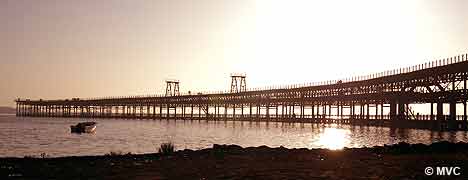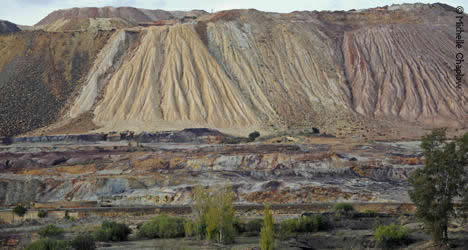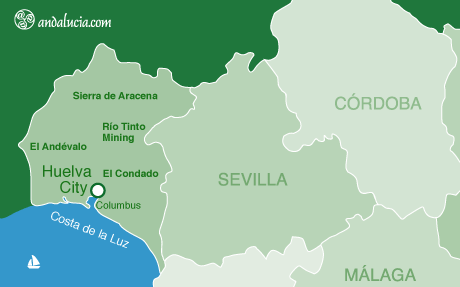
Rio Tinto MINing AREA
Arising out of the midst of the surrounding greenery, the giant opencast mines of Rio Tinto create a surreal, almost lunar landscape. The removal of layer upon layer of soil and rock, in the search for iron ore, copper, silver and a host of other mineral ores, has tinted this part of the world in hues of dusty pink, brown, yellow, red and grey. So great is the scale of operations, that the depression created resembles a man-made crater that measures several kilometres across. From the edge of the 'crater', a giant space opens up before you.
Walls of terraced rock, streaked with the unusual colours of mineral ores create the impression of a natural amphitheatre of gargantuan proportions, that could easily be mistaken for the set of a Star Wars movie.
Rio Tinto is, however, more than an isolated cavity on the earth's surface. Its growth has consumed not only mountains and valleys but even entire villages, whose populations had to be resettled in specially built towns nearby. Named after the river which flows through the region-itself named for the reddish streaks that colour its water-Rio Tinto has become a landscape within a landscape. The unearthed minerals give the soil and waters of the region odd, otherworldly shades of blue, green, yellow, red and brown, so it is not unusual to see bright orange or green rivulets trickling past. The predominant ores, however, are the ferrous ones, which oxidise when they come into contact with the air and colour land and river alike in shades of reddish brown. Even as far as Niebla, roughly 50 kilometres to the south-east, the waters of the Rio Tinto still flow past the town's ancient fortified walls in an eerie trickle of blood-red.
Villages
Campofrio is situated within the Comarca Minera (mining area) of El Andevalo and is said to have one of the oldest bullrings in Spain dating back to 1716. It has around 800 inhabitants.
La Granada de Rio Tinto is situated within the Rio Tinto mining district of El Andevalo, to the very far east of the province, bordering the Sierra de Aracena. It has 223 inhabitants.
El Campillo is situated very near Minas de Rio Tinto and covers an area of 91km², at an altitude of 434m above sea level. It sits in the centre of the Comarca de la Cuenca Minera de Riotinto (the… More →
Nerva is located 4km east of Minas de Rio Tinto, and its fate has been similarly entwined with that of the famous mines. The mine you can visit as part of the Mining Park, Peña del Hierro, is… More →
Minas de Riotinto is one of the most important towns of the province of Huelva. Situated south of Aracena in the comarca (area) Minas de Rio Tinto, it has around 4,000 inhabitants.

Rio Tinto Mining
The Rio Tinto area of Huelva boasts 3,000 years of mining history, from the Phoenicians then Romans, right up to to the 1990s. Today, as part of the Rio Tinto Mining Park you can visit the museum… More →
Copper is a metal and chemical element with the symbol Cu. Its name derives from the Latin cuprum. It is a soft ductile metal with very high thermal and electrical conductivity. A freshly exposed… More →
Arising out of the midst of the surrounding greenery, the giant opencast mines of Rio Tinto create a surreal, almost lunar landscape. The removal of layer upon layer of soil and rock, in the… More →
Book Hotels in Rio Tinto
History
According to myth, Rio Tinto is the fabled mines of King Solomon, and a section of the area is still known as Cerro Salomón today. Tales of the Iberian Peninsula's mineral wealth that drew Phoenician merchants to its shores, followed by a succession of Greek, Carthaginian and Roman invasions. The Rio Tinto mines were worked so intensively by the Romans they were among the most prized rewards that control of Iberia yielded. .
The mines were rediscovered in 1556 but it was not until 1724 the mines were reopened. Frustration, under investment, corruption and inefficiency dogged their exploitation when they were run by either the state or a series of entrepenueral lease holders. The ore was transported to port of Seville by mule and cart. Fed up with this situation, the Spanish government decided to sell the mines. Read the full history of the Rio Tinto Mines.
RIO TINTO COMPANY LTD
The mines were bought at auction at auction on 14 February 1873 by a British syndicate led by Hugh Matheson's Matheson and Company, which ultimately formed a syndicate consisting of Deutsche Bank (56% ownership), Matheson (24%), and railway firm Clark, Punchard and Company (20%) The winning bid was 92 million pesetas ( £ 3,680,000) a price later determined to be about 25% below their real value. The bid specified that Spain permanently relinquish any right to claim royalties on the mine's production. The syndicate launched the Rio Tinto Company, registering it on 29 March 1873. At the end of the 1880s, control of the company was passed to the Rothschild family, who greatly increased the scale of its mining operations.
In true Anglo-Saxon style, the company's British managers soon had the mines running at full steam, literaly by construcing a railway to the coast to export the ore and bing in workers. Rio Tinto became one of the most important sources of copper and sulphur in the world. Also true to form was the way in which they built Bella Vista, a purpose-built village for British employees only. Known as the 'colonia inglesa', the British style houses, neatly trimmed gardens, tennis lawns and social club of Bella Vista can still be visited. This 'British' village in the middle of the Andalusian countryside also features a Presbyterian Church. Several kilometres away is the modern town of Minas de Rio Tinto, built to replace an older settlement that was swallowed up by the mine's expansion. The towns old hospital now houses an impressive mining museum. From 1877 to 1891, the Rio Tinto Mine was the world's leading producer of copper.
On 4th February 1888 there was a demonstration by the local people against the bad air caused by the mineral productions. On the orders of the civil governor of Huelva, Regiment of Pavia, marched over from Malaga, opened fire on the demonstrators concentrated in the Plaza de la Constitution. This caused betwwen 13 and 100 deaths (depending on whose account). The power of the company's influence was so strong that these serious events went practically unnoticed in the rest of Spain for many many years. Concha Espina a writer living in Nerva, told the story in her 1922 book "El metal de los muertos" (The metal of Death). Local poet and writer Juan Cobos Wilkins's bestselling novel El Corazon de la Tierra (The Heart of the Earth), based on the story of a popular uprising at the mines in 1888, was recently made into an Anglo-Spanish film. It was filmed using locals as extras (many of whose ancestors took part in the original events), and locations included the town of Las Minas itself, with Bella Vista houses featured, Corta Atalaya mine, as well as Linares de la Sierra, Trigueros and Mazagon.
Art Galleries
There is an illustrated exhibition of the mining activities in the area from prehistoric times to the present day at the Museo Minero de Riotinto.
Parque Minero Rio Tinto
Tel: 959 59 00 25
Opening Times:
21 September-15 July, Monday-Sunday, 10.30-15.00hrs and 16.00-19.00hrs
16 July-20 September, Monday-Sunday, 10.30-15.00hrs and 16.00-20.00hrs
Football and Golf
In its heyday, the Rio Tinto Mining Company was quite an innovator. The football pitch and golf course built here were among the first on the European continent, and the half-timbered bungalows built for company employees at Punta Umbria, on the Huelva coast, are the forerunners of the modern Costas. The company became later known as RTZ (Rio Tinto Zinc) and today, it has no comercial interest in the area, is known as Rio Tinto plc.
A similar impact was made in the City of Huelva, which flourished as Rio Tinto's export harbour. The Rio Tinto pier, now renovated, remains one of Huelva city's greatest architectural monuments, along with the so-called Barrio Inglés, a small residential district built for British company workers. The superb archaeological section of the Museo Provincial de Bellas Artes has a collection of findings from the Rio Tinto area.
Nationialised
After difficulties during the Spanish civil war, the second world war and General Francos nationalist polocies the Rio Tinto Mining Company sold two thirds of its shares in 1954 (and the rest a few years later) The mines were taken over by Compañía Española de Minas de Riotinto, later Unión de Explosivos Riotinto, Riotinto Patiño, Riotinto Minera and lastly Minas de Riotinto S.A.L. Due to the falling price of minerals the mines were closed in 2001.
PARQUE MINERO RIO TINTO
The "Parque Minero Riotinto" was set up in 1992, so that visitors can learn about the important history of these mines. It comprises a museum, a typical victorian mining engineeers house, a guided visit to the mines, and a train ride on the mining railway alongside the red coloured Rio Tinto.
MINING Today
EMED Tartessus a Spanish company owned by the multinational EMED Mining is restablishiing mining activity in Riotinto. In 2014 preparatory works begain with earth moving machinery operative again. On the 17th April 2015 the earth shook in Rio Tinto for the first time in 14 years at the company used 6.500 tonne of explosive to remove 28.000 tonne of sterile rock.
Book your stay in Andalucia Now!
